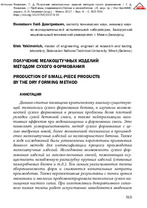| dc.contributor.author | Якимович, Г. Д. | ru |
| dc.coverage.spatial | Минск | ru |
| dc.date.accessioned | 2021-04-29T10:04:02Z | |
| dc.date.available | 2021-04-29T10:04:02Z | |
| dc.date.issued | 2017 | ru |
| dc.identifier.citation | Якимович, Г. Д. Получение мелкоштучных изделий методом сухого формования = Production of small-piece products by the dry forming method / Г. Д. Якимович // Проблемы современного бетона и железобетона : сборник научных трудов / Министерство архитектуры и строительства Республики Беларусь, РУП "Институт БелНИИС". – Минск : Издательский центр БГУ, 2012. - Вып. 9 / пред. редкол. О. Н. Лешкевич. – Минск : Колорград, 2017. – С. 515-530. | ru |
| dc.identifier.uri | https://rep.bntu.by/handle/data/90866 | en |
| dc.description.abstract | Данная статья посвящена критическому анализу существующей технологии сухого формования бетона, в изучении возможностей сухого формования в решении проблемы более плотной укладки сухой бетонной смеси, а также нейтрализации негативных эффектов при водонасыщении и формовании смеси. Это позволяет усовершенствовать метод сухого формования с целью внедрения новой, более экономичной технологии в производство мелкоштучных изделий из мелкозернистого бетона. Также в ходе исследований были установлены перспективы применения данного метода для интенсификации процесса производства мелкоштучных изделий. Исследована возможность сухого формования изделий из гипсово-песчаных смесей, позволяющая осуществлять немедленную распалубку крупных изделий (стеновых пазогребневых блоков и т.д.). Тем самым увеличиваются темпы оборачиваемости форм и снижаются капитальные затраты производства. Также перспективные результаты с точки зрения экономики и экологии продемонстрировала технология сухого насыщения чистого гипса. При изготовлении декоративного гипсового камня темпы работ искусственно замедляются введением добавок-пластификаторов, которые повышают прочность замедляющих схватывание и позволяют производить качественное уплотнение гипсового теста. Технология сухого формования же, наоборот, позволяет добавление в состав измельчённого двуводного гипса из отбракованных изделий, что при сохранении должного качества конечного изделия сокращает как сроки распалубки, так и затраты на утилизацию отбракованного материала и иных отходов гипса. Серия экспериментов с гипсом позволила выделить наиболее рациональную область использования технологии сухого формования, а именно формование тонкослойных (до 40мм) изделий из быстросхватывающихся смесей. Ведётся работа над проектированием смесей на основе цемента «быстряка», также обладающего крайне короткими сроками схватывания и высокими темпами твердения в суточном возрасте. Предполагается, что реализация такой технологии позволит существенно уменьшить время оборачиваемости форм, а также снизить или полностью избежать энергетических затрат на термообработку мелкоштучных изделий. | ru |
| dc.language.iso | ru | ru |
| dc.publisher | Колорград | ru |
| dc.title | Получение мелкоштучных изделий методом сухого формования | ru |
| dc.title.alternative | Production of small-piece products by the dry forming method | en |
| dc.type | Article | en |
| local.description.annotation | This article is devoted to critical analysis of existent technology of the dry forming of concrete, study of possibilities of the dry forming
in the decision of problem of more dense piling of dry concrete mixture, and also neutralization of negative effects at a water saturation and the mixture forming. This allows us to improve the method of dry molding in order to introduce a new, more economical technology in the production of small-piece products from fine-grained concrete. Also in the course of research, the prospects of using this method for intensifying the process of production of small pieces were established. Possibility of the dry shaping of wares is investigational from gypsum sandy mixtures, allowing to carry out immediate form removal of large wares gypsum wall blocks and etc.). The rates of mould reusability increase the same and the capital costs of production go down. Also, perspective results from the point of view of economy and ecology were shown by technology of dry saturation of clean gypsum. At making of gypsum decorative bricks the rates of works are artificially slowed by introduction of addition517 plasticizers that promote durability, slowing grasping and allow to produce the quality consolidation of gypsum. The technology of dry molding is the opposite, adding to the composition of grinded gypsum from defective products, which, while maintaining the proper quality of the final production, both the unpacking time and the disposal costs of the rejected
material and other wastes of gypsum are reduced. A series of experiments with gypsum made it possible to single out the most rational area of using dry-molding technology, namely, the formation of thin-layered (up to 40 mm) products from fast-setting mixtures. Work is under way on the design of mixtures based on the «flash setting» cement, which also has an extremely short setting time and reaching a curing rate at a diurnal age. It is assumed that the realization of such technologies can reduce the mould reusability, also reduce or avoid the energy costs. | en |

